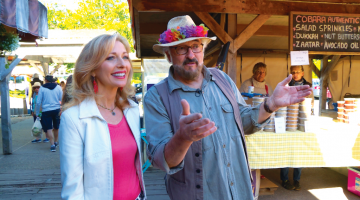Above: Linda on the Maori waka we visited in New Zealand. To check out a video of a modern waka caught in a storm, click here!
The Maori tribe has long inhabited New Zealand as it’s first settlers. Today their tribes still thrive on it’s coast and are keeping up it’s ancient ancestral traditions. This includes reviving the Maori way of navigation. Traditionally the Polynesian people navigated their way through the pacific in canoes, which the Maori referred to as a waka.
New Zealand’s abundance of wide-girthed trees such as tōtara meant that Māori could build much more diverse waka (canoes) than in their Polynesian homeland. They developed a variety of vessels for coastal and inland waterways. Each had its special function, from the grand carved waka taua for … In the past, Māori used waka (canoes) just as we use cars today. New Zealand’s waterways were like roads, running along the coast and up rivers. Waka would be paddled along them, carrying people and goods. Some Māori still build traditional waka today. Polynesian voyaging waka … A waka taua, traditionally used by warriors …
How the Waka Resurgence Began
Waka ama are widely used in the Pacific for fishing, carrying goods, travel and racing. Waka racing is a popular sport in Hawaii and French Polynesia.
In New Zealand there was a resurgence of interest in waka ama in the late 1980s, after the double-hulled canoe Hawaikinui was built and sailed from Tahiti to New Zealand. Clubs were set up around the country, and in 1987 a national body was formed. National championships have been held annually since 1989. Since 1990 New Zealand has sent teams to the World Va’a (waka) Championships every two years. New Zealand teams have become world champions in some divisions.
In 2012 the national body, Waka Ama NZ, represented over 1,000 members in 43 clubs.
Most waka ama today are built out of composite materials such as fibreglass. Designers try to make them faster and more responsive. Waka ama clubs often emphasise Māori language and customs associated with waka building and paddling. Waka ama are mostly used for racing, but some people also use them for fishing, or just for fun.
Waka Navigation
Voyagers knew land was ahead even before they could see it. Migrating birds may have helped show the way to new lands, and fishing birds such as gannets, terns and petrels were a sign that land was not far away. Pods of whales may also have guided canoes to New Zealand – the ancestor Paikea is said to have arrived on a whale.
Navigators could also find land by reading the position of stars, the colour and formation of clouds, and the pattern of waves.
To check out a video of a modern waka caught in a storm, click here!
© Crown copyright 2005–2016 Manatū Taonga Ministry for Culture and Heritage, PO Box 5364, Wellington 6145, New Zealand. Tel: +64 4 499 4229; Fax: +64 4 499 4490; Email:TeAra@mch.govt.nz





No Comment